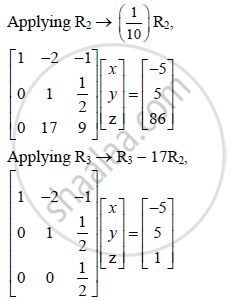Advertisements
Advertisements
प्रश्न
The cost of 2 books, 6 notebooks and 3 pens is Rs 40. The cost of 3 books, 4 notebooks and 2 pens is Rs 35, while the cost of 5 books, 7 notebooks and 4 pens is Rs 61. Using this information and matrix method, find the cost of 1 book, 1 notebook and 1 pen separately.
उत्तर
Let the cost of 1 book, 1 notebook and 1 pen be Rs x, Rs y and Rs z respectively.
According to the given conditions,
2x + 6y + 3z = 40
3x + 4y + 2z = 35
5x + 7y + 4z = 61
These equations can be written in the matrix form as


By equality of matrices,\
x − 2y − z = −5 ….(i)
y + z/2= 5 ….(ii)
z/2 = 1 ….(iii)
From (iii), z = 2
Putting z = 2 in (ii), we get
y + 1 = 5
∴ y = 4
Putting y = 4, z = 2 in (i), we get
x − 8 − 2 = − 5
∴ x = 5
Thus, the cost of 1 book, 1 notebook and 1 pen are 5, 4 and 2 respectively
APPEARS IN
संबंधित प्रश्न
The sum of three numbers is 6. When second number is subtracted from thrice the sum of first and third number, we get number 10. Four times the sum of third number is subtracted from five times the sum of first and second number, the result is 3. Using above information, find these three numbers by matrix method.
Solve the following equations by the method of reduction :
2x-y + z=1, x + 2y +3z = 8, 3x + y-4z=1.
The sum of three numbers is 9. If we multiply third number by 3 and add to the second number, we get 16. By adding the first and the third number and then subtracting twice the second number from this sum, we get 6. Use this information and find the system of linear equations. Hence, find the three numbers using matrices.
Use elementary column operation C2 → C2 + 2C1 in the following matrix equation :
`[[2,1],[2,0]] = [[3,1],[2,0]] [[1,0],[-1,1]]`
If `A=|[2,0,-1],[5,1,0],[0,1,3]|` , then find A-1 using elementary row operations
Prove that `|(yz-x^2,zx-y^2,xy-z^2),(zx-y^2,xy-z^2,yz-x^2),(xy-z^2,yz-x^2,zx-y^2)|`is divisible by (x + y + z) and hence find the quotient.
Using elementary row transformations, find the inverse of the matrix A = `[(1,2,3),(2,5,7),(-2,-4,-5)]`
Prove that :
2x − 3z + w = 1
x − y + 2w = 1
− 3y + z + w = 1
x + y + z = 1
2x − y = 5
4x − 2y = 7
Use elementary column operation C2 → C2 + 2C1 in the following matrix equation : \[\begin{bmatrix} 2 & 1 \\ 2 & 0\end{bmatrix} = \begin{bmatrix}3 & 1 \\ 2 & 0\end{bmatrix}\begin{bmatrix}1 & 0 \\ - 1 & 1\end{bmatrix}\]
Apply the given elementary transformation on each of the following matrices `[(2, 4),(1, -5)]`, C1 ↔ C2.
Apply the given elementary transformation on each of the following matrices `[(3, 1, -1),(1, 3, 1),(-1, 1, 3)]`, 3R2 and C2 ↔ C2 – 4C1.
Transform `[(1, -1, 2),(2, 1, 3),(3, 2, 4)]` into an upper traingular matrix by suitable row transformations.
Find the cofactor matrix, of the following matrices : `[(1, 2),(5, -8)]`
Find the cofactor matrix, of the following matrices: `[(5, 8, 7),(-1, -2, 1),(-2, 1, 1)]`
Choose the correct alternative.
If A = `[("a", 0, 0),(0, "a", 0),(0, 0,"a")]`, then |adj.A| = _______
Choose the correct alternative.
If A = `[(2, 5),(1, 3)]`, then A–1 = _______
The suitable elementary row transformation which will reduce the matrix `[(1, 0),(2, 1)]` into identity matrix is ______
The cofactors of the elements of the first column of the matrix A = `[(2,0,-1),(3,1,2),(-1,1,2)]` are ______.
If `overlinea = hati + hatj + hatk, overlinea . overlineb = 1` and `overlinea xx overlineb = hatj - hatk,` then `overlineb` = ______
If `[(1, 0, -1),(0, 2, 1),(1, -2, 0)] [(x),(y),(z)] = [(1),(2),(3)]`, then the values of x, y, z respectively are ______.
If `[(2, 3), (3, 1)][(x), (y)] = [(-5), (3)]`, then the values of x and y respectively are ______
If A = `[(1, 2, 1), (3, 2, 3), (2, 1, 2)]`, then `a_11A_11 + a_21A_21 + a_31A_31` = ______
In the matrix A = `[("a", 1, x),(2, sqrt(3), x^2 - y),(0, 5, (-2)/5)]`, write: elements a23, a31, a12
If P = `[(x, 0, 0),(0, y, 0),(0, 0, z)]` and Q = `[("a", 0, 0),(0, "b", 0),(0, 0, "c")]`, prove that PQ = `[(x"a", 0, 0),(0, y"b", 0),(0, 0, z"c")]` = QP
If A = `[(0, -1, 2),(4, 3, -4)]` and B = `[(4, 0),(1, 3),(2, 6)]`, then verify that: (A′)′ = A
If A = `[(0, -1, 2),(4, 3, -4)]` and B = `[(4, 0),(1, 3),(2, 6)]`, then verify that: (kA)' = (kA')
Find the matrix A such that `[(2, -1),(1, 0),(-3, 4)] "A" = [(-1, -8, -10),(1, -2, -5),(9, 22, 15)]`
If possible, using elementary row transformations, find the inverse of the following matrices
`[(2, 0, -1),(5, 1, 0),(0, 1, 3)]`
In applying one or more row operations while finding A–1 by elementary row operations, we obtain all zeros in one or more, then A–1 ______.
If A = `[(2, 3, -1),(1, 4, 2)]` and B = `[(2, 3),(4, 5),(2, 1)]`, then AB and BA are defined and equal.
If f(x) = `|(1 + sin^2x, cos^2x, 4 sin 2x),(sin^2x, 1 + cos^2x, 4 sin 2x),(sin^2 x, cos^2 x, 1 + 4 sin 2x)|`
What is the maximum value of f(x)?
